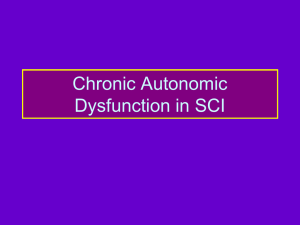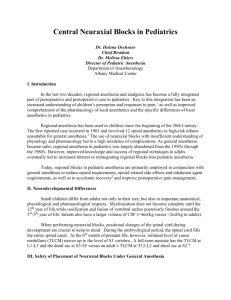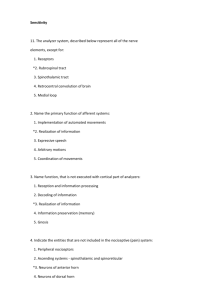Anesthesia for Autonomic Hyperreflexia
advertisement
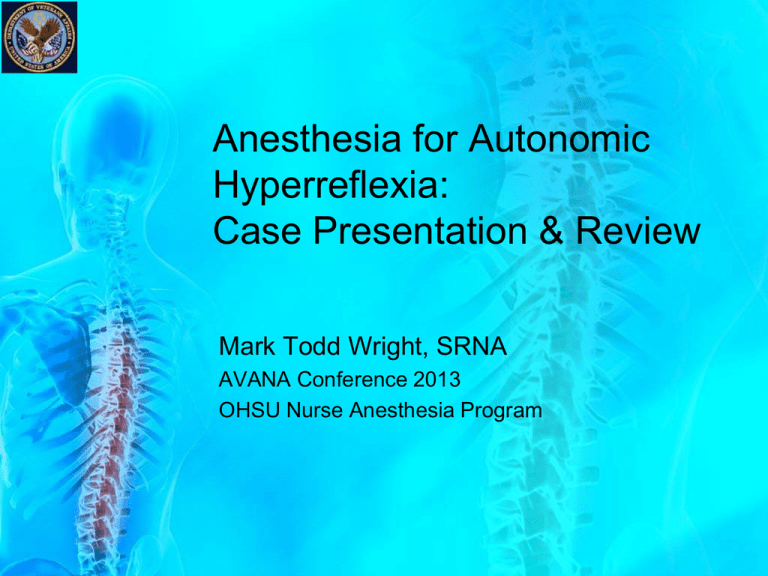
Anesthesia for Autonomic Hyperreflexia: Case Presentation & Review Mark Todd Wright, SRNA AVANA Conference 2013 OHSU Nurse Anesthesia Program Disclosures • $10,000 from AVANA Case Presentation Autonomic Hyperreflexia AH Case Presentation • 63 y/o M, scheduled for a sigmoid colectomy w/ colostomy. • NKA • BMI 29.3 / 98 Kg • Tobacco: 20 pk/yr (quit 2007) AH Case Presentation Active Problems • Quadriplegia—C5-C7 transection • X6 yrs • Chronic pain • Oxycodone 5 mg 1-2 tabs q 4 hrs • Venlafaxine 75 mg daily • Mild RAD—Duoneb prn (rare use) AH Case Presentation Medical History • AH during previous anesthetic • HTN-resolved AH Case Presentation Labs & Diagnostics HR: 63 BP: 123/73 RR: 16 SpO2: 98% 12-lead EKG: NSR (01/2013) BMP: WNL Hgb: 11.1 Hct: 36.0 Plt: 157 INR 1.2 T: 36.6˚C AH Case Presentation Airway/ROS Auscultation: RRR CTA Airway ROM: (-) Dentition: (-) Neck: (-) T→D: (-) ULBT: grade I Mouth: > 3 cm MP: 2 Anatomy palp: easy AH Case Presentation Spinal & Induction • SAB @ L3-L4 (+CSF) • Midazolam 1 mg IV • Bupi 12 mg + Epi wash • 500 mL LR co-load • Induction • Lidocaine 60 mg • Fentanyl 100 mcg • Propofol 120 mg • Rocuronium 50 mg AH Case Presentation: Maintenance, Emergence, & Postop • Sevoflurane 1-1.5% • BIS 40-50 • Fentanyl prn • Nipride gtt (readily available) AH Case Presentation: Maintenance, Emergence, & Postop Autonomic Hyperreflexia/Dysreflexia • Episodic & potentially life-threatening HTN that develops in pts w/ spinal cord lesion at or above T6. • Occurs > 85% • Caused by noxious, visceral, or nociceptive stimuli below spinal lesion • SBP ↑ > 20-30 mmHg VA & Spinal Cord Injury (SCI) 250,000 Americans w/ serious SCI • 42,000 SCI Veterans/heroes • 26,000 (2008) • 13,000 specialty care (2008) AH Pathophysiology Review 1) Stimulus below transection. 2) Activation of preganglionic sympathetic nerves 3) Vasoconstriction 4) HTN 5) Stimulation of carotid sinus = bradycardia 6) Reflexive cutaneous vasodilation AH Clinical Presentation Awake: • C/o HA, blurred vision, nasal stuffiness Anesthetized: • Hallmarks: HTN & Bradycardia • Piloerection & flushing (above) Untreated: • • • • • Loss of consciousness Seizures Cardiac dysrhythmias Cerebral, retinal, or subarachnoid hemorrhage ↑ afterload → LV failure & pulm edema Autonomic Hyperreflexia AH Anesthetic Implications Pre-op • HEENT—↓ ROM & mouthing opening • CV—↓ BP, orthostatic hypoTN • Pulm—↓ lung volumes, cough reflex, atelectasis • GI—atonicity, full stomach? • Renal—UTI, chronic FC • CNS—bowel & bladder dysfunction, chronic & central pain AH Anesthetic Implications Treatment • Nifedipine or prazosin prophylaxis • STOP the stimulus (if possible) • Neuraxial block & GA • SAB > EA &/or GA > N2O + opioid • Vasodilators • SNP, Nicardipine • BB for tachyarrhythmias • NOTE: centrally acting hypotensive agents are not effective (clonidine) AH Anesthetic Implications Clinical Pearls • NDNMB prn • SCh & profound hyperK+ • Common triggers: • Irritation of urinary bladder, colon, & labor • Waning of anesthesia (post-op) • Literature is lacking for definitive treatment References 1. 2. 3. 4. 5. Fleisher LA, Roizen MF. Essence of Anesthesia Practice. 3rd ed. Philadelphia/Elsevier. 2011; 10. Hines RL, Marshall KE eds. Stoelting’s Anesthesia and Co-Existing Disease. 5th ed. Philadelphia: Churchill Livingstone/Elsevier; 2008. Lagarto, F., Pina, P.. Autonomic Dysreflexia - a clinical case: 4AP8-7. Eur J Anaesthesiol. 2012;29:75. Cited in: Your Journals@Ovid Full Text at http://ovidsp.ovid.com/ovidweb.cgi?T=JS&PAGE=reference&D=yrovftm&NE WS=N&AN=00003643-201206001-00243. Accessed April 02, 2013. Groothuis, Jan, Rongen, Gerard, Deinum, Jaap, et al. Sympathetic Nonadrenergic Transmission Contributes to Autonomic Dysreflexia in Spinal Cord-Injured Individuals. Hypertension. 2010;55(3):636-643. doi:10.1161/HYPERTENSIONAHA.109.147330 Stevens, Robert, Bhardwaj, Anish, Kirsch, Jeffrey, Mirski, Marek. Critical Care and Perioperative Management in Traumatic Spinal Cord Injury. J Neurosurg Anesthesiol. 2003;15(3):215-229. Cited in: Your Journals@Ovid Full Text at http://ovidsp.ovid.com/ovidweb.cgi?T=JS&PAGE=reference&D=yrovftf&NEW S=N&AN=00008506-200307000-00009. Accessed April 02, 2013. References 5. 6. BROECKER, B., HRANOWSKY, N., HACKLER, R.. Low Spinal Anesthesia for the Prevention of Autonomic Dysreflexia in the Spinal Cord Injury Patient. Surv. anesthesiol.. 1980;24(3):184. Cited in: Your Journals@Ovid Full Text at http://ovidsp.ovid.com/ovidweb.cgi?T=JS&PAGE=reference&D=yrovfta&NE WS=N&AN=00132586-198006000-00050. Accessed April 02, 2013. Spinal Cord Injury Fact Sheet for Veterans: http://www1.va.gov/opa/publications/factsheets/fs_spinal_cord_injury.pdf




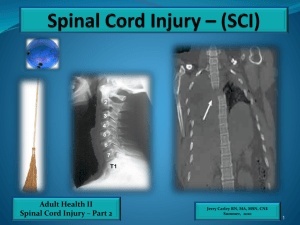
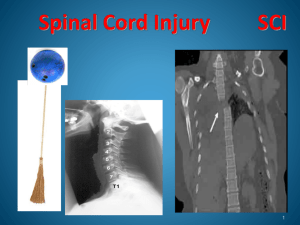


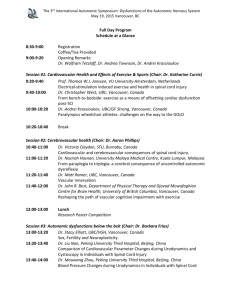
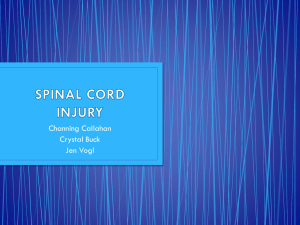


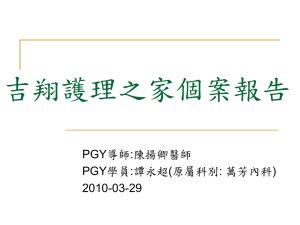

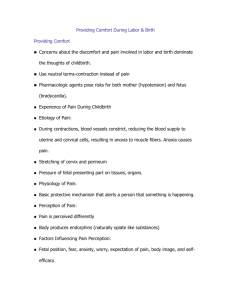

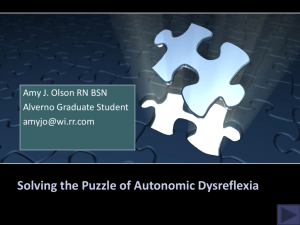
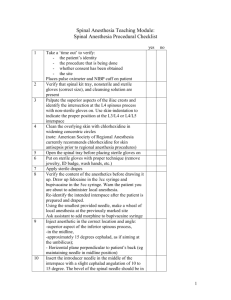
![Spinal Anaesthesia [PPT]](http://s3.studylib.net/store/data/009374756_1-e6b13846b64cff2eb8bb3fcdd8d6dfc2-300x300.png)
